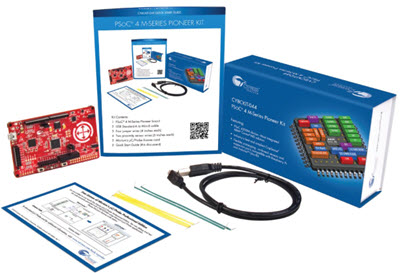|
For novel ideas about building embedded systems (both hardware and firmware), join the 35,000 engineers who subscribe to The Embedded Muse, a free biweekly newsletter. The Muse has no hype and no vendor PR. Click here to subscribe.

|
This month's giveaway is a Cypress CY8KIT-044 PSoC 4 M-series Pioneer kit. Enter here. |
|
By Jack Ganssle
State of Grace
Published 11/29/06
A quarter century ago Grace Hopper gave me a nanosecond.
Admiral Hopper is renowned as one of the first women in computing, and was certainly one of the most influential of all computer scientists. One of her 1953 inventions - the compiler - is probably today the most important tool we embedded folks use. Can you imagine being stuck coding in assembly today? Her first compiler, called "A", eventually morphed into COBOL, a language that will still be around when the sun dies out. A little bit of Grace will live on nearly forever.
Born 100 years ago this week (Dec 9, 1906) she was the third person to join the research team of Professor Howard H. Aiken, who had requested her months earlier and greeted her with the words, "Where the hell have you been?" Then he pointed to the Mark I electromechanical computing machine: "There's the machine. Compute the coefficients of the arc tangent series by next Thursday." The Mark I was a five ton electromechanical beast driven by a 50 foot shaft and 4 horsepower motor, with no conditional instructions. Need a loop? Glue two ends of the paper tape together.
Active, energetic, she reminded me of Buckminister Fuller, another visionary I had the honor of meeting, and another who is now departed and missed. Though pushing 80 at the time, she was far more dynamic than most of us much younger folks attending her presentation. She gave each of the 20 or so of us there a piece of telephone wire - the solid copper kind with thin, color-coded insulation - that was about a foot long. "It takes electricity one nanosecond to propagate through that wire" she lectured, hoping (successfully) to awe us with the miniscule nature of 1 nsec.
Now, of course, a nanosecond is a huge quantity. My $1000 desktop cycles at 2.6 GHz, or about 385 picoseconds. I wonder what the Admiral would have thought of these advances, for she died on January 1, 1992, when desktop machines ran at a paltry ten megahertz (100 nanosecond cycle times) or so.
Yet today I still use her example when explaining the concept of a nanosecond to non-techies. I hold my hands a foot apart, mentally calibrating the distance to the remembered wire. That trivial bit of copper disappeared years ago, probably crinkled into a ball of lab-bench waste. I miss it, for it forged a bit of a connection to the earliest days of computing, and to one of the industry's most interesting people.
Admiral Hoper is also often erroneously credited with finding the first software bug - a moth fried in relay contacts of the Mark II computer. Like original sin that's another legacy we've inherited, one none of us relish. But her bug wasn't a programming error.
Happy birthday, Grace - we miss you!